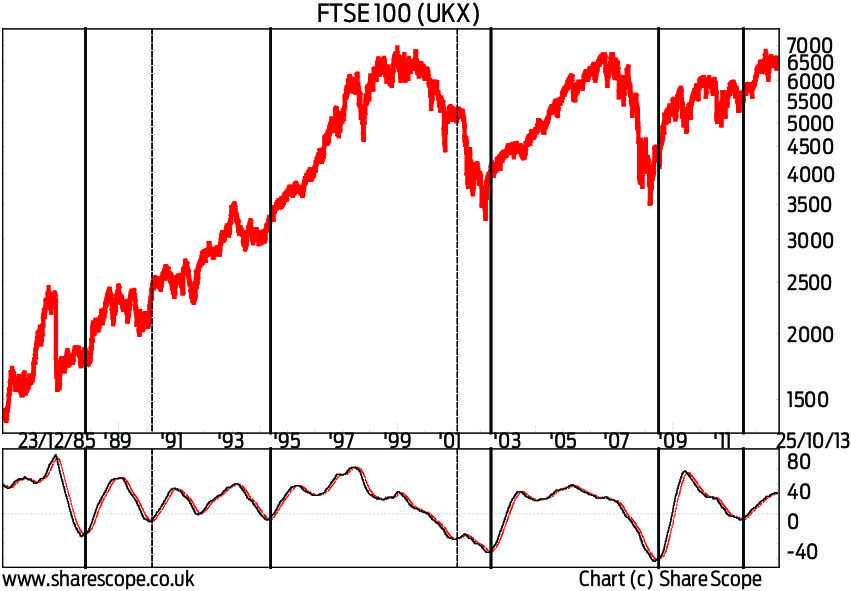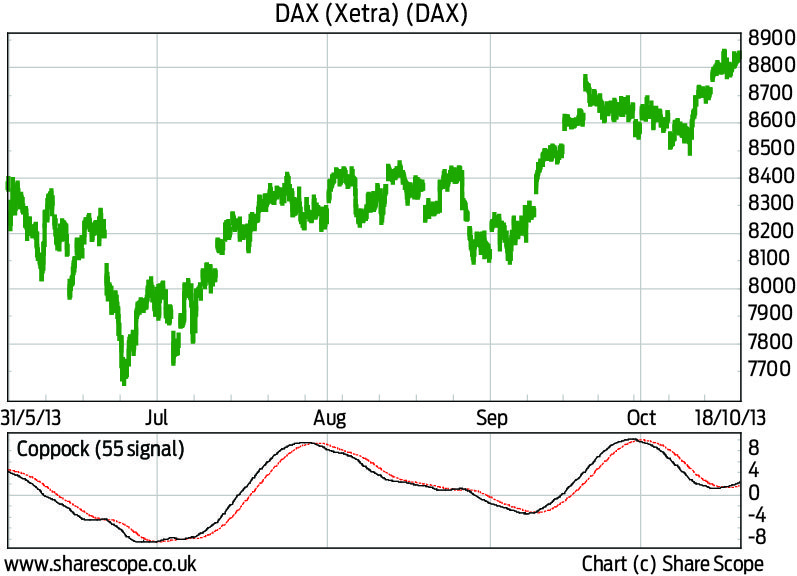COPPOCK
In an attempt to determine the extent to which previous events had an ongoing bearing on the mood and direction of markets, Edwin Coppock sought to develop a system for identifying long-term buying opportunities. Since market falls are a traumatic event for many, his thesis was that a period of market ?mourning? would be needed before conditions favoured a return to a more positive outlook. He discovered from discussions with the elders of the Episcopal Church that there was a recognised mean period over which the acceptance of a personal loss was gradually achieved. This he concluded lay between 11 and 14 months and this idea was to form the basis for his indicator.
Originally designed purely as a buying signal for US indices and first published in Barron?s in late 1962, Coppock?s Very Long Term Momentum indicator (VLTM) is a respected market timing tool. Its value lies in confirming whether markets are witnessing a new primary up trend or merely a short-lived bear market correction. At the top markets tend to gradually lose momentum while bottoms often come after a sharp spike down from which recovery quickly springs. The Coppock indicator?s weighted smoothing reacts relatively quickly to such changes after falls and its only issues a signal when it goes below zero and then begins to rise again. It does not have to recover above zero for the signal to flare. Whilst Coppock himself did not offer any conditions under which his indicator would issue a sell signal, latterly some technical analysts have suggested that peaks whilst posting positive values might at least work as a cautionary alerts to the possible the end of a upward or bull trend.
The original calculation is made using end-of-month values for indices and computed from a ten-month weighted average of the average of an 11-month and 14-month rate of change, where the rate of change is the ratio of average prices over those two separate time periods. The Coppock indicator can also be successfully derived by using weekly or even daily price data using the same time periods as the monthly figures. If daily data are deployed, the calculation would use a 208-day weighted average of the sum of a 229-day and a 292-day rate of price change.
Whilst the indicator tends to give relatively infrequent signals they in the main successfully flag significant market advances, although with the advent of futures and day trading some chartists do use Coppock to spot key turning points on intraday charts.
A long- term FTSE 100 index day chart back to 1985 shows the seven instances of below-zero Coppock 'buy' signals. All but two, those of early 1991 and 2002, moved quickly into profit. The last signal was visible in August of last year when the index stood at 5,693. It has since advanced by 16.3%.
This 30-minute intraday bar chart of Germany's Dax index dates back to June and uses an unorthodox Coppock indicator and a 55-period moving average trigger line. In this case the indicator is calculated on the basis of bars rather than days. Both of the signals produced as it turns up from zero prove to be excellent opportunities buying opportunities.




